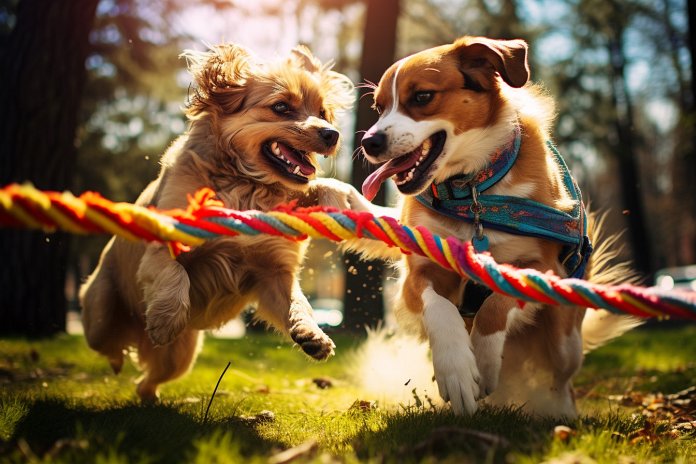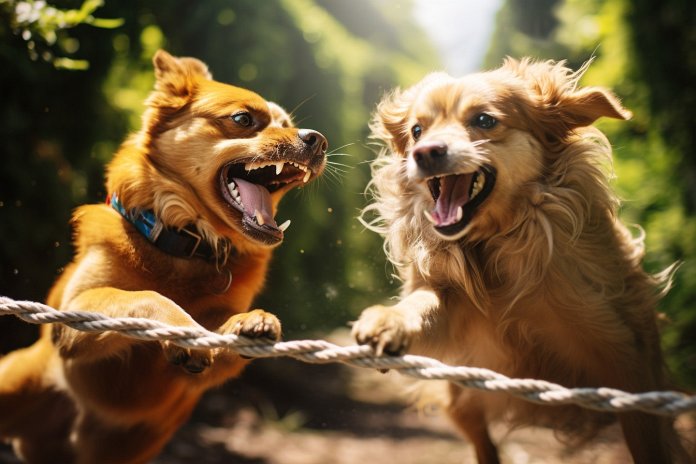
The game of tug-of-war brings back memories of playing outside or during elementary school field day activities.
Playing tug-of-war with your dog can be a lot of fun. Dogs are natural experts at playing this game and they enjoy playing with humans or other dogs. But how can you tell if your dog wants to play? There are a few signs to watch out for.
Signs Your Dog Wants to Play
Most dogs love to play, although it depends on their temperament. You can tell if your dog wants to play if they start jumping up or pacing by the door, indicating that they want to go outside and play. They may open their mouth, pant, put their ears up, and wag their tail rapidly. Dogs also do something called a “play bow,” which is when they bend their front forward and put their behind in the air. This is a universal signal that dogs want to play. Your dog may also grab toys and bring them to you as a signal that they are ready to play. If you don’t start playing with your dog, they might start playing tug-of-war with whatever you’re holding to get your attention.
Body Language
Signs that your dog wants to play include panting, jumping up, pacing, ears up, and play bowing.
Other Signs
Other signs that your dog wants to play include bringing toys to you, mouthing whatever you are holding, and excited behavior.
History of Dogs and Tug-of-War
Tug-of-war has been a popular game for many years. It was a rural pastime in England and Scotland and was even an Olympic event from 1900 to 1920. Dogs have likely been playing tug-of-war with humans for a long time, as it is a common occurrence among siblings and even with early humans. Dogs love tug-of-war so much that pet stores sell specific toys for this game. However, you can play tug-of-war with anything, from a shoe to an old rag.
Science Behind Dogs and Tug-of-War
Dogs love tug-of-war because it taps into their natural hunting instincts. The catching and pulling involved in the game bring out their basic instincts. Additionally, in canine packs, battling over items helps establish dominance and challenge strengths.
Training your Dog to Play Tug-of-War
Dogs seem to know how to play tug-of-war instinctively, as they start exhibiting this behavior when they are puppies. You don’t need to train them to play, but you can teach them variations of the game if you want. However, it’s important to be mindful of your dog’s temperament and needs. Some dogs may not enjoy playing tug-of-war, so don’t force them. Also, keep an eye on your dog’s behavior, especially if they seem aggressive or are playing with children. While research doesn’t indicate that tug-of-war makes dogs aggressive, it’s better to be safe. If your dog becomes too aggressive or starts snapping or growling in a warning tone, it’s best to stop playing the game and let your dog cool off. In some cases, it may be better to not let everyone play tug-of-war with your dog if it agitates them. Overall, most dogs love tug-of-war and enjoy playing, so have fun playing with your furry friend!
“Dogs seem to have an innate love for tug-of-war, a game that not only taps into their natural hunting instincts but also serves as a means of establishing dominance and challenging strengths within canine packs.”

Tips & Things to Know
1️⃣ Look out for signs that your dog wants to play tug-of-war, such as them starting to jump, pace by the door, pant, put their ears up, wag their tail, or bring toys to you. A “play bow” where they bend their front forward and put their behind in the air is a universal signal among dogs wanting to play.
2️⃣ Tug-of-war is a game that taps into a dog’s natural hunting instincts. It’s a common behaviour in canine packs for establishing dominance and challenging strengths. However, not all dogs enjoy this game and it’s important not to force them to play if they don’t seem interested.
3️⃣ While most dogs love tug-of-war and it doesn’t necessarily make them aggressive, it’s crucial to keep an eye on your dog’s behaviour during the game. If they start to show signs of aggression or discomfort, like snapping or growling, it’s best to stop the game and let them cool down. In some cases, it might be better to restrict who can play tug-of-war with your dog, especially if they seem agitated.
Frequently Asked Questions, Answered ✅
1. How can you tell if your dog wants to play?
– Signs that your dog wants to play include jumping up, pacing by the door, opening their mouth, panting, putting their ears up, wagging their tail rapidly, and doing a play bow.
2. What are some other signs that indicate a dog wants to play?
– Other signs that your dog wants to play include bringing toys to you, mouthing whatever you are holding, and exhibiting excited behavior.
3. What is the history of dogs and tug-of-war?
– Tug-of-war has been a popular game for many years, even being an Olympic event from 1900 to 1920. It was a rural pastime in England and Scotland. Dogs likely have been playing tug-of-war with humans for a long time, as it is a common occurrence among siblings and early humans.
4. Why do dogs love tug-of-war?
– Dogs love tug-of-war because it taps into their natural hunting instincts. The catching and pulling involved in the game bring out their basic instincts. Additionally, in canine packs, battling over items helps establish dominance and challenge strengths.
5. Can you train your dog to play tug-of-war?
– Dogs seem to know how to play tug-of-war instinctively, but you can teach them variations of the game if you want. However, it’s important to be mindful of your dog’s temperament and needs. Some dogs may not enjoy playing tug-of-war, so don’t force them. Additionally, monitor your dog’s behavior and be cautious if they show signs of aggression.